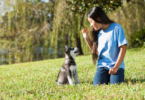Are you wondering why your dog isn't responding to basic commands? Understanding effective training methods is key to fostering good behavior in your pet. Positive reinforcement stands out as a highly recommended approach, offering long-term success and strengthening the bond between you and your dog.
Experts emphasize the importance of timing and consistency in training. Starting early ensures a strong foundation for your dog's behavior. By setting clear, consistent commands, you can avoid confusion and help your dog learn more efficiently.
This article will guide you through practical tips to improve your dog's behavior, ensuring good behavior during sessions and making time for regular practice. You'll discover proven strategies supported by professionals, blending scientific insights with real-life examples to create a detailed, accessible plan for effective training.
Understanding the Fundamentals of Dog Training
Effective dog training starts with understanding how your pet learns. By focusing on clear commands and consistent rewards, you can create a strong foundation for their behavior. This approach helps avoid confusion and makes learning more efficient for your pet.
Benefits of Positive Reinforcement
Positive reinforcement is a powerful method that encourages good behavior through rewards. When you use treats or praise immediately after a desired action, your pet is more likely to repeat that behavior. This technique builds trust and strengthens your bond with your pet.
Using treats wisely is key. Choose small, tasty rewards and give them right after the desired action. This helps your pet connect the treat with the behavior you want. Avoid giving treats for unwanted actions, as this can confuse your pet and slow down their learning.
Common Training Pitfalls to Avoid
One common mistake is being inconsistent with commands. Make sure everyone in your household uses the same cues to avoid confusing your pet. Another pitfall is accidentally rewarding bad behavior, which can undo your progress.
A well-structured training session should be short and focused. Start with simple commands and gradually introduce more complex ones. Keep sessions fun and engaging to maintain your pet's interest and motivation.
Building a Successful Training Routine
Creating an effective training routine is essential for helping your pet learn and grow. A well-structured plan not only fits into your busy schedule but also adapts to your pet's unique needs. By breaking training into short, frequent sessions, you can keep your pet engaged and focused, which is crucial for successful learning.
Short and Frequent Sessions
Experts recommend keeping training sessions brief and regular. Short sessions prevent frustration and maintain your pet's interest. For example, three 10-minute sessions a day can be more effective than one long session. This approach works especially well for puppies with shorter attention spans.
Choosing the Right Environment
The environment plays a significant role in your pet's learning. Start in a quiet, controlled situation to minimize distractions. As your pet becomes more confident, gradually introduce new environments to help them generalize commands. This method ensures your pet can respond consistently in various situations.
Combining structured routines with playful engagement makes training sessions interactive and fun. For instance, incorporating games that teach commands can make learning enjoyable for your pet. Setting a consistent daily routine helps support your pet's learning curve and ensures steady progress.
Essential Commands and Behavioral Skills
Mastering basic commands is vital for any pet owner. Commands like “sit,” “stay,” and “come” are not just about obedience—they’re essential for safety and daily interactions. These skills help you maintain control and ensure your pet’s well-being in various situations.
Teaching Sit, Stay, and Come
Start with the “sit” command. Hold a treat above your pet’s head and move it backward toward their tail. As they follow the treat with their nose, they’ll naturally sit down. Make sure to reward them immediately. For “stay,” begin with your pet in a sitting position, take a few steps back, and return with a treat. Gradually increase the distance and time you’re away.
The “come” command is crucial for safety. Call your pet by name, use an upbeat tone, and reward them with a treat when they respond. Consistency is key—ensure everyone in your household uses the same cues to avoid confusion.
Incorporating Fun Tricks for Engagement
Add fun tricks like “shake hands” or “roll over” to keep training sessions lively. These activities not only entertain your pet but also strengthen your bond. Use positive reinforcement with treats and praise to encourage learning. Remember, every person plays a significant role in guiding the training process, fostering trust and clear communication.
Advanced Training Techniques for All Breeds
Once your pet has mastered the basics, it’s time to explore more complex behaviors. Advanced techniques can help refine your pet's skills and deepen your bond. These methods are designed to challenge your pet while keeping them engaged and motivated.
Utilizing Hand Signals and Verbal Cues
Combining hand signals with verbal cues adds clarity to your communication. For example, pairing the “sit” command with a downward palm gesture helps your pet understand the action. This dual approach is especially useful in noisy environments where verbal cues might be drowned out. Over time, your pet will learn to respond to either cue, giving you more flexibility.
Stage-Based Progression in Complex Behaviors
Breaking complex tricks into stages makes learning manageable. Start with simple actions, like touching a target stick, then gradually add steps. For instance, teaching a “spin” trick can begin with a slight turn, rewarding progress, and increasing the spin as your pet becomes confident. This method ensures steady improvement without overwhelming your pet.
Joining a training class offers professional guidance and personalized feedback. Trainers can help address challenges, ensuring your pet stays motivated. Practicing in various places, from parks to busy streets, reinforces learned behaviors, helping your pet generalize commands in any setting. With patience and consistency, your pet can master even the most intricate tricks.
Proven Dog Training Tips for Everyday Behavior
Every day presents new opportunities to guide your pet toward better behavior. By integrating simple yet effective techniques into your daily routine, you can help your companion stay calm and focused, even in challenging situations. Positive reinforcement training plays a key role in this process, offering a reliable method to address common challenges like housebreaking and leash manners.
Housebreaking and Leash Training Techniques
Housebreaking is a lot easier when you stick to a consistent schedule. Take your pet outside first thing in the morning and after meals to create a routine they can follow. Positive reinforcement training works wonders here—reward successful trips outside with treats and praise to reinforce good habits.
For leash training, start in a quiet area with minimal distractions. Use a front-clip harness to gently guide your pet, and reward them with treats when they walk calmly by your side. Over time, introduce busier environments to help them stay focused.
Managing Barking and Distraction Challenges
Barking can be a lot to handle, but staying calm is key. Identify what triggers the barking and use positive reinforcement training to teach your pet the “quiet” command. When they stop barking, reward them with a treat to reinforce the behavior.
Distracted environments can be tough, but consistent training helps. Use short, positive commands like “stay” to keep your pet focused. Over time, they’ll learn to stay calm and attentive, even when a lot is happening around them.
Integrating Training into Daily Life
Making training a natural part of your daily routine can lead to lasting behavioral changes for your pet. By weaving simple commands into everyday activities, you create consistent learning opportunities that feel effortless for both you and your companion.
Embedding Commands into Routine Activities
Start by using moments like mealtimes or walks to reinforce basic commands. For example, have your pet sit before serving their food or wait before putting on their leash. These small, consistent practices help solidify their understanding of commands in real-life situations.
Another effective strategy is to use positive reinforcement during daily interactions. Reward your pet with treats or praise when they respond correctly, even in distracted environments. Over time, this method builds their ability to focus and respond reliably, no matter the setting.
Consistency is key to successful integration. Clear, simple cues and regular practice ensure that your pet develops long-lasting habits. By making training a seamless part of your daily routine, you foster a balanced and engaging approach to learning that benefits both you and your companion.
Final Thoughts on Cultivating a Loyal Companion
Cultivating a loyal companion is a journey that begins with patience and consistency. Every little thing you do, from early puppyhood to adulthood, shapes your pet's behavior and strengthens your bond.
Starting early with your puppy and continuing reinforcement training as your pup matures is key. This approach ensures a strong foundation for their behavior and helps them grow into a well-behaved companion.
Remember to use positive methods that build attention and trust over time. Consistency is crucial, as it helps your pet understand what is expected of them and reinforces good behavior.
Expert advice reminds us that patience and continuous engagement are essential. Every interaction, whether during training or play, is an opportunity to guide your pet toward better behavior.
Reinforcement training is more than just a method—it's a journey that transforms both you and your beloved companion. With time and effort, you can create a lifelong partnership built on trust, understanding, and mutual respect.











Leave a Comment